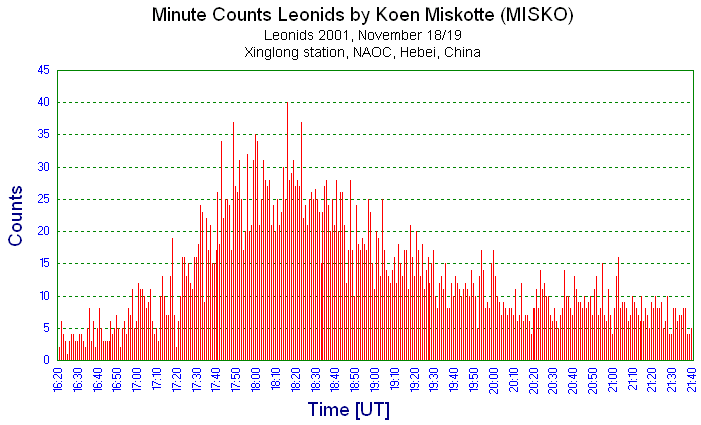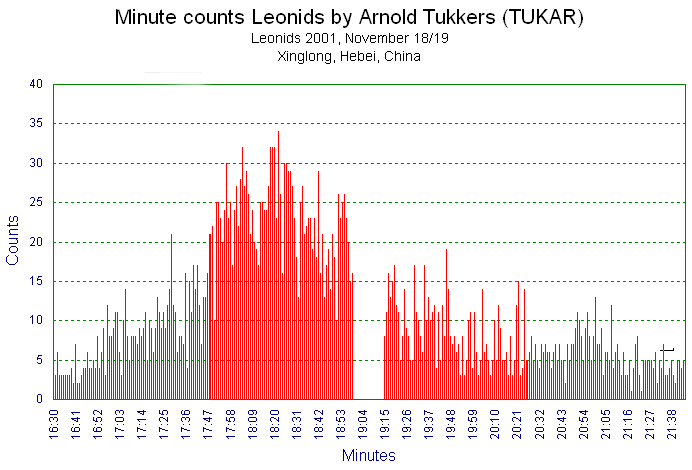Press Release:
A group of international observers at the Xinglong Station of the National Astronomical Observatories of the Chinese Academy of Sciences in China observed the Leonids on the night of 18/19 November. The Xinglong Station is located about 110 kilometers north-east of Beijing. The Leonids are dustparticles which are released while the comet 55P/Tempel-Tuttle passes the sun every 33 years. The meteors are called Leonids because they seem to emerge from the constellation of Leo.
Tonight the observers experienced a real meteor storm. That is, meteors appeared at a rate of about 40 meteors per minute at maximum. It looked like meteors where raining from the sky, and at certain moments 8 meteors appeared at the same time. It seemed to the observers as though they could really see the earth moving through space. Rates went up from 15:00 UT (Greenwich mean time) when the Leonid radiant rose above the eastern horizon. The maximum was at about 18:06 UT, and after this time rates went down slowly. Many fireballs were observed especially in the second part of the night.
The Sino-Dutch Leonid Expedition 2001 had set up 4 stations near the Xinglong area to provide multistation photography and video observations of the Leonid meteors. The aim is to compute the orbital elements of the meteoroid dust particles in space. Equipment at all stations performed flawlessly. The Sino-Dutch Leonid Expedition 2001 is a close collaboration between Chinese and Dutch astronomers to gain knowledge of the Leonid meteor stream and its
Observers include:
| Dr. Jin Zhu of the NAOC, China | Lew Gramer of NAMN, USA |
| Dr. Xiaojun Jiang of NAOC, China | Arnold Tukkers of DMS, the Netherlands |
| Bin Yang of NAOC, China | Casper ter Kuile of DMS, the Netherlands |
| Dan Xia of BMS, China | Jos Nijland of DMS, the Netherlands |
| Huan Meng of BMS, China | Koen Miskotte of DMS, the Netherlands |
| Jian Gao of BNU, China | Michel Vandeputte of VVS, Belgium |
| Min Guan of BNU, China | Robert Haas of DMS, the Netherlands |
| Rui Qi of QHU, China | Sietse Dijkstra of DMS, the Netherlands |
| Wenzhong Liu of BNU, China | |
| Xuefei Gong of BNU, China | |
| Yongming Chen of BMS, China |
References:
- Website of the International Meteor Organisation: http://www.imo.net
- Website of the Dutch Meteor Society: www.dmsweb.org
- Website of the Sino-Dutch Leonid Expedition 2001: http://vega.bac.pku.edu.cn/~zj/meteor/SDLE2001.html
Information contact:
Mr. A.S. Tukkers
Th. v.d. Borghstraat 9
NL-7591 TT Denekamp, The Netherlands
Phone: +31-541-354598 / +31-541-229700
E-mail: a.tukkers@planet.nl
| Station | North | East | Altitude |
|---|---|---|---|
| Xinglong | 40 23 46,7 | 117 34 41,8 | 916 |
| San Path | 40 04 39,0 | 117 17 10,2 | 111 |
| Miyun | 40 23 29,3 | 116 58 36,1 | 176 |
| Great Wall | 40 31 | 116 32 | - |
- "Hazenarray" consisting of 11 Canon T-70 camera's with Canon 1.8/50 mm lenses. 4 camera's aimed at 75 degrees, 7 camera's aimed at 50 degrees.
- Rotating shutter: 12.5 rpm, 6 blades, yielding 75 breaks per second
- Film: Kodak Tri-X 400
- Start of exposure: 15:30 UT (22:30 local time)
- End of exposure: 22:30 UT (05:30 local time)
- Exposure time: 12 minutes
- Total number of exposures: 36
- Total exposure time: 420 minutes
- Mullard XX1332 second generation Multi Channel Plate (MCP) Image Intensifier with 50 windows
- Canon 1.2/50 mm lens
- Panasonic NV-DA1 camcorder
from Xinglong station, Hebei, China
| Interval | MISKO | TUKAR | XIADA | ZHUJI |
|---|---|---|---|---|
| 14:00 - 15:00 | 2 | 1 | 0 | 0 |
| 15:00 - 16:00 | 37 | 54 | 18 | 21 |
| 16:00 - 17:00 | 215 | 207 | 99 | 0 |
| 17:00 - 18:00 | 924 | 756 | 493 | 0 |
| 18:00 - 19:00 | 1335 | 1388 | 777 | 635 |
| 19:00 - 20:00 | 735 | 435 | 310 | 0 |
| 20:00 - 21:00 | 504 | 407 | 55 | 0 |
| 21:00 - 22:00 | 327 | 226 | 0 | 0 |


- Lm (limiting Magnitude) = 6.6
- Cp (Perception Coefficient) = 1.2
- r (Population Index) = 2.58
- RH (Radiant Height) = 32 degrees
- Gamma = -1.0
- Total observing time = 360 minutes
- Total number of meteors = 4000
- BIN = Total observing time (min) / SQRT(total observed meteors : 360 / SQRT(4000) = 5 minutes
- Dr. Jin Zhu, NAOC, CAS: full support of Sino-Dutch Leonid Expedition 2001 in China
- Dr. Jiang, NAOC, CAS: counterpart related to lichtcurves
- Student 1: hulp bij Jos en Sietse in Miyun station
- Student 2: hulp bij Robert en Michel in PanShan station
- Student 3: hulp bij Ro bert en Michel in PanShan station
- CSA-Amsterdam/Schiphol: Marcel Bakker: Cargo
- CSA-Amsterdam/Schiphol: Lianne Baai: Tickets, Sponsoring
- CSA-Beijing: Mrs. Ma
- CSA-Beijing: Mrs. Duan
- Stichting J.C. van der Meulen: Sponsoring kamerabatterij
- Rijvers metaal: Jaco Rijvers: grondplaten video-opstellingen
- Arena Multimedia: Peter van Rijswijk: bruikleen video camcorder & statieven
- PTT-Post internationaal: Dhr. Bos: tracking image intensifiers
- RIVM/LSO: Dhr R. Overwater: connectie naar de Bos
- EMO-Elektronics: Herr Harder: Image Intensifiers
- Reuters Press
- Bossmann: sweaters
- Wessels: Stickers
- Ben Kokkeler (Cosmos): Memorandum of Understanding and other organisational aspects
- Dr. Porubcan: Letter of recommendation
- Dr. Ceplecha: Letter of recommendation